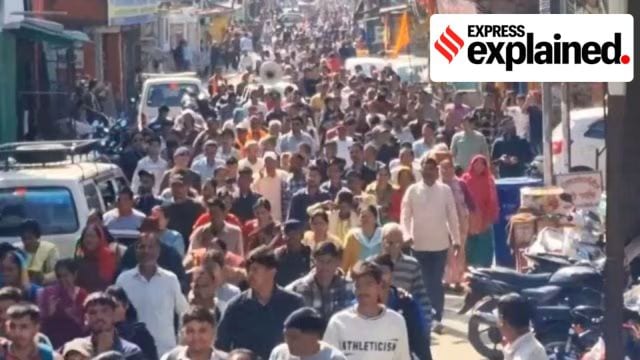As Uttarakhand celebrates its 25th anniversary since formation on November 9, a group of villagers from Almora’s Chaukhutia has commenced a 300 km march to Dehradun, demanding better healthcare services.
The hill state is home to 578 primary health centres, 81 community health centres, 21 sub-district hospitals, and 13 district hospitals spread across its 13 districts. However, health and education have lagged for over 1 crore people, manifesting as a driving force for emigration.

The protest demanding better facilities and specialists in Chaukhutia CHC started on October 2 with the slogans: “Swasthya sewayen bahal karo, doctor do, aspatal bachao (Boost health services, provide doctors, save hospitals)”. It gained attention after one of the protest leaders undertook a hunger strike and had to be hospitalised.
Story continues below this ad
Institutional healthcare
The state’s healthcare system has repeatedly come under the scanner, with at least two Comptroller and Auditor General reports over the past decade exposing its poor condition.
Although the state government framed a recruitment policy for General Duty Medical Officers (GDMOs) requiring MBBS qualifications, there was no policy for specialist doctors’ recruitment, a CAG report for 2016-21 released earlier this year showed. This has resulted in a shortage of doctors amounting to 94 per cent in CHCs, 45 per cent in Sub-District Hospitals, and 30 per cent in District Hospitals, as per Indian Public Health Standards (IPHS) norms.
The report also revealed a stark difference in the availability of doctors between the plains and hilly districts: In four plains districts, there was a 50 per cent shortage of specialist doctors against sanctioned posts, while in nine hilly districts, the shortage reached 70 per cent. The hill-plain divide can be found in the nurse shortage — Chamoli had a 75 per cent shortage, while Dehradun’s crunch was around 35 per cent.
The CAG report also revealed that the transfer policy for doctors was relaxed in the state and did not comply with the mandatory transfer after four years from easy access areas to tough terrain.
Story continues below this ad
The CAG audit for 2014-19, based on a survey of six hospitals across Almora, Haridwar, Udham Singh Nagar, and Chamoli, and released in 2021, revealed a lack of operating theatres for emergency surgeries in all the test-checked hospitals. An ICU facility was available in only two hospitals, which were non-functional due to a lack of essential equipment and specialised manpower. The audit observed that all hospitals failed to provide accident and trauma or psychiatry services during the period under study.
Where does the state stand in services and indicators?
Out of a budget of Rs 1 lakh crore for 2025-26, the state has allocated over Rs 4,000 crore in health. According to official data, the state possesses two MRIs, 23 CT scans, 73 ultrasound and 117 X-ray machines.
However, a recent Lancet study from April, “‘Miles to go before I seek’: distance to the health facility and health care use among older adults in India” by Misra S et al, indicates that services remain sub-par.
IN-PATIENT & OUT-PATIENT VISITS:
The Lancet study relied on the Longitudinal Survey of India data for 2017-18, and found that Uttarakhand has 29.2 per cent in-patient visits in hospitals within 10 km, but 36.3 per cent in-patient visits in facilities over 60 km away, the study revealed.
Story continues below this ad
The study similarly shows that over a 10-km radius, Nagaland has zero in-patient visits, while Sikkim has 17.6 per cent and Himachal Pradesh 4.5 per cent in-patient visits, highlighting the geographical challenges in hilly states over the same period. According to the study, states like Mizoram (51%), Nagaland (21.5%), and Himachal Pradesh (38.5%) saw higher percentages of inpatient visits at distances over 61 km over this period, indicating poor and limited accessibility to nearby health facilities.
However, outpatient visits within 10km stand at 60.4 per cent in Uttarakhand. It is the highest in Tripura (87.9%), Kerala (83.7%) and Manipur (78.4%). Over 8.8 per cent of visits are in facilities more than 60 km away in Uttarakhand.
CHILDBIRTHS:
Between 2019 and 2021, 80 per cent of births in rural Uttarakhand were institutional, but only 53 per cent of births occurred in a public facility, according to the National Family Health Survey 5. Moreover, 4.4 per cent of births occurred at home under the care of a skilled professional in rural areas, compared to 1.3 per cent in urban regions. Further, in rural areas, 16 per cent of births were delivered by caesarean, while only around 10 per cent of births in a public health facility were delivered by caesarean section as opposed to 40.9 per cent in private hospitals.
The 75th round of the National Sample Survey, held between July 2017 and June 2018, acutely reveals the rural-urban divide, or hill-plain divide, as in Uttarakhand’s case. Twenty-one per cent of non-institutional childbirths were in rural areas, while 6 per cent were in urban areas. Only 61 per cent of women aged 15-49 years in rural areas took prenatal care, compared to 95 per cent in urban areas.
Story continues below this ad
Continued concerns
Previously, the death of a one-year-old boy in Uttarakhand prompted a probe after he was referred to five hospitals across four districts, before passing away in the ICU. The son of an Army officer from Chamoli’s Gwaldam, he was initially taken to the primary health centre in the village after he showed signs of severe dehydration. Faced with inadequate services there, the family had to move the infant to four other hospitals in Bageshwar, Almora, and finally to Nainital’s Haldwani, where he died six days later.
More recently, in early October, a pregnant woman was forced to give birth on the floor at a government hospital in Haridwar, with videos of the incident going viral. This prompted the state women’s commission to step in to order a probe.
The remoteness of the villages and inadequate staff and facilities in smaller health centres previously resulted in government interventions. In 2020, following concerns that rural women were forced to walk miles to reach the nearest hospital even during pregnancy, the Nainital district administration introduced a palanquin service to ferry women in labour to hospitals, with Rs 10 lakh released to the chief medical officer to arrange 500 “dolis” or palanquins for rural areas to transport pregnant women to the nearest road head or hospital for delivery.







































